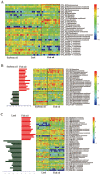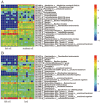Fish oil, lard and soybean oil differentially shape gut microbiota of middle-aged rats
- PMID: 28400577
- PMCID: PMC5429820
- DOI: 10.1038/s41598-017-00969-0
Fish oil, lard and soybean oil differentially shape gut microbiota of middle-aged rats
Erratum in
-
Erratum: Fish oil, lard and soybean oil differentially shape gut microbiota of middle-aged rats.Sci Rep. 2017 Aug 10;7(1):7738. doi: 10.1038/s41598-017-04862-8. Sci Rep. 2017. PMID: 28798472 Free PMC article.
Abstract
High-fat diets have been associated with overweight/obesity and increased mortality in middle-aged populations. However, it is still unclear how gut microbiota in middle-aged populations responds to dietary fats at a normal dose. In this study, we explored gut microbiota structure in middle-aged rats (aged 12 months) after feeding 4% (w/w) soybean oil, lard or fish oil for 3 months, respectively. The results showed that the gut microbiota structure in the fish oil group was substantially different from those of the soybean oil and lard groups in both in vitro and in vivo studies. The relative abundances of phylum Proteobacteria and genus Desulfovibrio in the caecal and colonic contents were the highest in the fish oil group (p < 0.05). The mRNA levels of biomarkers for inflammation in the colon, including IL-1β, IL-6, IL-17, IL-18 and TNF-α, were also the highest in the fish oil group (p < 0.05). Meanwhile, the fish oil group had the highest microbial DNA abundance of a predicted lipid metabolism. Our results gave a new insight into the potentially negative impact of fish oil diet on health of middle-aged populations by changing gut microbiota and inducing inflammation as compared to soybean oil and lard diets.
Conflict of interest statement
The authors declare that they have no competing interests.
Figures






Similar articles
-
Modulating effects of dietary fats on methylmercury toxicity and distribution in rats.Toxicology. 2007 Jan 25;230(1):22-44. doi: 10.1016/j.tox.2006.10.023. Epub 2006 Dec 20. Toxicology. 2007. PMID: 17184894
-
The effects of different high-fat (lard, soybean oil, corn oil or olive oil) diets supplemented with fructo-oligosaccharides on colonic alkaline phosphatase activity in rats.Eur J Nutr. 2021 Feb;60(1):89-99. doi: 10.1007/s00394-020-02219-y. Epub 2020 Mar 19. Eur J Nutr. 2021. PMID: 32193633
-
Dietary Combination of Fish Oil and Soy β-Conglycinin Inhibits Fat Accumulation and Reduces Blood Glucose Levels by Altering Gut Microbiome Composition in Diabetic/Obese KK-A y Mice.J Oleo Sci. 2023;72(3):303-312. doi: 10.5650/jos.ess22363. J Oleo Sci. 2023. PMID: 36878584
-
Dietary Fat Influences the Expression of Genes Related to Sterol Metabolism and the Composition of Cecal Microbiota and Its Metabolites in Rats.J Oleo Sci. 2019;68(11):1133-1147. doi: 10.5650/jos.ess19183. J Oleo Sci. 2019. PMID: 31695016
-
Dietary fat and gut microbiota interactions determine diet-induced obesity in mice.Mol Metab. 2016 Oct 13;5(12):1162-1174. doi: 10.1016/j.molmet.2016.10.001. eCollection 2016 Dec. Mol Metab. 2016. PMID: 27900259 Free PMC article.
Cited by
-
Microbial effects of cold-pressed Sacha inchi oil supplementation in rats.PLoS One. 2025 Feb 20;20(2):e0319066. doi: 10.1371/journal.pone.0319066. eCollection 2025. PLoS One. 2025. PMID: 39977445 Free PMC article.
-
Effects of Vitamin D3 and Marine Omega-3 Fatty Acids Supplementation on Biomarkers of Systemic Inflammation: 4-Year Findings from the VITAL Randomized Trial.Nutrients. 2022 Dec 14;14(24):5307. doi: 10.3390/nu14245307. Nutrients. 2022. PMID: 36558465 Free PMC article. Clinical Trial.
-
High-Fat Diets with Differential Fatty Acids Induce Obesity and Perturb Gut Microbiota in Honey Bee.Int J Mol Sci. 2021 Jan 15;22(2):834. doi: 10.3390/ijms22020834. Int J Mol Sci. 2021. PMID: 33467664 Free PMC article.
-
Effect of different types of oil intake on the blood index and the intestinal flora of rats.AMB Express. 2022 May 5;12(1):49. doi: 10.1186/s13568-022-01387-w. AMB Express. 2022. PMID: 35511307 Free PMC article.
-
Peony seed oil decreases plasma cholesterol and favorably modulates gut microbiota in hypercholesterolemic hamsters.Eur J Nutr. 2022 Aug;61(5):2341-2356. doi: 10.1007/s00394-021-02785-9. Epub 2022 Feb 2. Eur J Nutr. 2022. PMID: 35107625
References
-
- Levinson DJ. A conception of adult development. Am.J. Psychol. 1986;41:3–13. doi: 10.1037/0003-066X.41.1.3. - DOI
-
- Flurkey, K., Currer, J. M. & Harrison, D. E. The Mouse in Biomedical Research, The Mouse in Biomedical Research (2nd Edition). 10.1016/B978-012369454-6/50074-1, 637–672 (2007).
Publication types
MeSH terms
Substances
LinkOut - more resources
Full Text Sources
Other Literature Sources
Medical
Molecular Biology Databases
Miscellaneous

